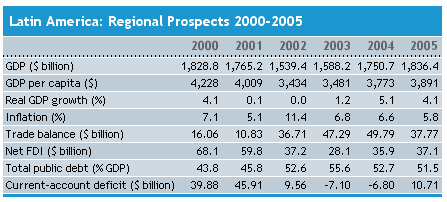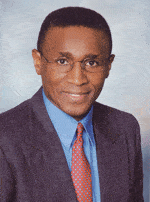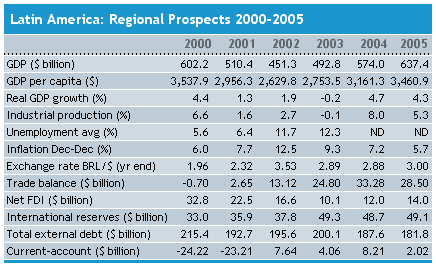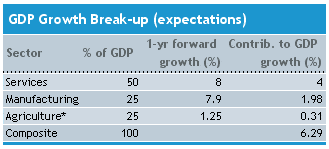 As 2005 begins to unfold, investors and corporates around the world have plenty of reasons to be optimistic. Despite some serious setbacks through the year, 2004 turned out well. By mid-December all the main US equities indexes were comfortably in positive territory, and investors were looking forward to more of the same from 2005. Markets around the world had largely stabilized, and many of the bigger emerging markets were posting strong gains, confounding skeptics who feared a hard landing in China, economic turbulence in Brazil and dire fallout from the Indian elections that saw the demise of a reform-friendly administration.
As 2005 begins to unfold, investors and corporates around the world have plenty of reasons to be optimistic. Despite some serious setbacks through the year, 2004 turned out well. By mid-December all the main US equities indexes were comfortably in positive territory, and investors were looking forward to more of the same from 2005. Markets around the world had largely stabilized, and many of the bigger emerging markets were posting strong gains, confounding skeptics who feared a hard landing in China, economic turbulence in Brazil and dire fallout from the Indian elections that saw the demise of a reform-friendly administration.Gloomy predictions that the dramatic rise in popularity of high-yield bonds would lead to disaster had also failed to come true. In fact, the darkest cloud on the horizon is the decline in the value of the dollar. Even that has been touted as a reason to be cheerful by those who believe a weaker dollar will solve many of the most pressing problems facing the world’s economies.
It remains to be seen just how far the dollar will fall and what impact the adjustment will have on the US and its trading partners. Certainly the European and Asian economies are suffering, with exports to the US being squeezed by their rising relative costs.
But the dollar is just one factor in play as the world’s economies embark on what promises to be an exciting and potentially prosperous year.
Dollar’s fate will determine region’s economic fortunes.
 |
Fariborz Ghadar |
Henry Willmore, chief US economist at Barclay’s Capital in New York City, says the surge in housing prices and rising equity markets has produced an increase in household net worth that will keep consumers spending in the coming year. He is also bullish on the US labor market and expects a continuation of the 2004 job growth that saw the addition of more than 2 million jobs.
“The fundamentals for consumers are a bit better, and businesses are relatively in good shape,” says Willmore. “They have cash flow and look very good. And with the dollar low, exports should stabilize or improve.”
A recent survey of chief financial officers conducted by a division of Bank of America showed that three out of four CFOs believe the national economy will grow this year. The annual survey, The Bank of America Business Capital 2005 CFO Outlook, was conducted in October 2004 with the chief financial officers at 600 mid-size and large US manufacturers. But the survey showed that only 44% of the CFOs expected the US manufacturing sector to expand this year, down from 53% in 2004. The financial executives cited the cost of materials and energy costs as their top two concerns.
Fariborz Ghadar, director of the Center for Global Business Studies at Pennsylvania State University in University Park, Pennsylvania, says he isn’t surprised that most CFOs are positive about the US economy’s prospects.
“The CFOs are rolling in cash. They’re not making investments, and they’re buying back their debt,” says Ghadar, who also serves as a consultant to a score of major corporations and governments. “Business is good, and they are profitable,” he notes.
Ghadar, who admits he is more optimistic than many other economic experts, adds that he is not worried by the dollar’s falling value against other currencies. “I’m concerned with the falling dollar if I want to buy a BMW. But if I’m a manufacturer who wants to compete in the global marketplace, I’m not concerned,” he says.
And like other economic observers, he believes oil prices will remain steady in the low $40-per-barrel range. He attributes last year’s spike in oil prices to more than $50 per barrel to labor strikes in Nigeria and Venezuela and the clash with Iran over the nuclear situation.
Others offer a more pessimistic outlook. Robert H. Parks, an economist and professor of finance at Pace University’s Lubin School of Business in New York City, says the runaway US budget deficit and widening current account deficit, coupled with continued military spending for the war in Iraq, points to financial trouble in the coming year.
“I see the global outlook as bleak to black,” says Parks. He expects the US to enter a recession that will mirror the 1981-1982 years of the Reagan administration. “The war is being financed by the printing presses, just like Johnson did,” says Parks.
Analysts expect the same type of economic conditions to play out in Canada. “They mimic us a bit, although they didn’t suffer the same downturn as us during 2001 and 2002, and more recently they’ve lagged on the upturn,” says Josh Feinman, chief economist at Deutsche Asset Management Americas in New York City. One reason behind that lag is the strength of the Canadian dollar, which has hurt the export of Canadian products into the United States. The Canadian economy is expected to grow by 3.2% this year, up slightly from 3% in 2004, according to figures released by the Canadian embassy in Washington.
Wrestles With Conflicting Demands
 |
Peter Szopo |
D’Arvisenet predicts that some respite may come in the second half of 2005 as oil prices ease, with headline inflation in Europe expected to decline to 1.8% over the year. “We expect oil prices to come down from next winter,” d’Arvisenet says, “but it depends on the political situation.” The appreciation of the euro against the dollar has also helped ease the inflationary burden of oil prices, which means the ECB is unlikely to intervene until at least the end of the first quarter 2005, and even then, BNP Paribas predicts, any hike in interest rates will be minimal—perhaps 25 basis points.
The strong euro has bolstered euro-denominated government and bond markets, but with interest rates expected to rise, the outlook for government paper in 2005 is less optimistic. “The government bond markets could struggle,” says Paul Hearn, global head, primary markets, BNP Paribas, adding that the outlook for issuance in other credit bonds in 2005 remains low. “There is relatively limited supply in the corporate bond markets, with investment grade volumes down significantly,” he says.
The ECB’s September forecast for 2005 growth (1.8% to 2.8%) now looks optimistic, with economists predicting that growth of 2% is more realistic. Continued appreciation of the euro, depressed consumer demand, high unemployment (8.8% predicted for the eurozone in 2005) and insufficient balance sheet restructuring could affect growth stability in 2005. “More could be done to increase sustainable long-term growth and improve the euro area’s ability to adjust to shocks,” the IMF writes in its 2004 World Economic Outlook.
With unemployment in Germany exceeding the 4.4 million mark in October, the government instigated a program of wage restraint and labor flexibility. D’Arvisenet anticipates that other major eurozone economies such as Italy could implement similar measures. Western European countries have also had to combat competitive pressures from lower cost centers within the accession countries. German manufacturers DaimlerChrysler and Siemens negotiated increases in the working week up to 40 hours, without any wage compensation, in return for guaranteeing that jobs would not be cut or production sites relocated to cheaper centers. Although the 10 accession countries account for only 5% of EU GDP, economic growth (upwards of 4% in real GDP terms) and equity performance has historically been stronger in Central and Eastern Europe (CEE) than in Western Europe.
But weakened economic growth for the EU in general, the prospect of interest rate hikes and further weakening of the US dollar are likely to trim growth prospects for CEE. “2004 was the best year for emerging Europe because global growth was strong and interest rates globally were low,” comments Peter Szopo, head of market research, Bank Austria Creditanstalt. “Equities in the region had outperformed Western Europe for the last three years, but next year prospects are less benign.”
One of the consequences of high growth has been an increase in imports, which has widened current account deficits in countries such as Estonia, where it currently stands at 14.5% of GDP. Szopo says while this is cause for concern, deficits in the region were not expected to widen further, and opportunities for FDI in the region remained attractive.
Feeble Dollar Threatens To Slay Asian Tigers
 |
Jimmy Yap |
Economies across the region are growing, but higher oil prices and a slowing US economy are likely to take their toll in the coming year, with the IMF predicting “continued solid but slowing growth.” Regional GDP growth is expected to moderate to 6.5% in 2005.
According to the Asian Development Outlook (ADO) from the Asian Development Bank (ADB), countries such as China, India, Thailand and Vietnam are expected to lead the region’s growth. Japan’s gradual economic recovery is expected to continue, but a slowing of global demand is expected to cause real GDP growth to decline to 1.6% in 2005 compared with 3.4% in 2004, according to the Mitsubishi Research Institute.
If the dollar continues its slide, however, all bets are off. John Hewson, member of the advisory council, ABN AMRO Bank, Australia, says if the US dollar plummets, it could lead to an exchange rate crisis in the region. “Asia is sitting on a powder keg in terms of exchange rates,” he says. “The [Chinese] yuan is way undervalued. As soon as it changes, the relativities of other currencies will need to change.” Japan recently threatened to sell off its multi-billion dollar US holdings unless the Bush administration intervened to counteract the declining dollar. Overheating of the Chinese economy could also have a negative impact on the growth of intra-regional trade, the ADB says in its ADO.
Hewson also highlighted the potential for heightened political risk across the region: “There are a range of new leaders in Asia, and in a policy sense, they are still untested,” he says. Despite efforts to restructure balance sheets and institute wide-ranging market reforms, he believes that Asian banking and financial systems are still unsophisticated by Western standards and that some countries had not addressed the issue of NPLs and bad debts.
| Strong Growth in Bond Issuance |
| One area that has undergone significant reform since the 1997 crisis is local currency government bond markets, the development of which has been fueled by market, legal and regulatory reforms in the ASEAN+3 countries. According to the ADB’s Asia Bond Monitor, East Asian local currency bonds outstanding increased from $356 billion in 1997 to $1.2 trillion in 2003. Most of this growth has come from government bonds, which were used to finance bank recapitalization and fiscal stimulus. However, Juzhong Zhuang, a principal economist with the ADB, expects to see in the coming year more diverse sources of growth beyond the government sector as asset-backed securities gain popularity, governments privatize state-owned companies, and contractual savings institutions such as pension funds develop and demand more diversified local currency debt securities. “Corporate bond markets are expected to grow more rapidly as government reforms and policies help to reduce impediments and create an environment conducive to development,” he says. Free trade agreements (FTAs) between the ASEAN group of countries are also expected to be an ongoing theme in 2005. Based on a proposal first mooted by Singapore, countries have begun signing FTAs on a bilateral basis with countries that did not want to participate initially. “Using this kind of approach is a smart way of looking at it,” says Jimmy Yap, Asia Pacific head, Deutsche Bank Global Cash Management for Corporates. “Those countries that aren’t in initially are under pressure to eventually join, and I am fairly optimistic that there will be some form of regional harmonization over time.” Anita Hawser |
Casts Its Gaze To The East

Hu, it seems, came bearing money. In Argentina he announced plans to invest nearly $20 billion over the next 10 years in a move that has improved the medium-term outlook for a country still struggling to recover from a severe economic recession. China is Argentina’s fourth-largest trading partner-behind Brazil, Chile and the US-and is set to take a greater share next year, as a new trade pact eliminating barriers on key Argentine products goes into effect.
Hu pledged investments of some $7 billion in Brazilian transportation projects, while trade deals should double China’s trade with Brazil to $20 billion by 2007. In cash-strapped Cuba he promised to invest $500 million in the nickel industry, which will begin shipping 4,400 tons of nickel to China each year starting in 2005. In Chile he attended the annual Asia-Pacific Economic Cooperation (APEC) summit and got the chance to network with other Latin presidents.
Hu also designated Argentina and Brazil as approved destinations for Chinese travelers-who have surpassed the Japanese among Asian outbound tourists-in a measure that has tourism officials smiling broadly. Cuba had received a similar designation in 2003. The final tally for investment pledges during Hu’s visit was more than $30 billion, which will go a long way in the region’s economic rebound.
| Strong Growth Continues |
The World Bank predicts the region will grow by 4.7% in 2004 and 3.7% in both 2005 and 2006, following a meager 1.6% expansion in 2003. The recovery, which ends three years of stagnation, has been driven by high commodity prices, increased capital flows and strong growth in the US and Europe, as well as improved country fundamentals. Predictions that the rebound will cool off slightly this year are based on a projected slowing of world trade growth, moderation in oil and other commodity prices and higher international interest rates. Santiago Fittipaldi |
Shrugging Off Turmoil, Mideast Aims For Growth
 |
Jon Alterman |
While the Israelis and Palestinians continue to clash and US forces remain in Iraq, the Royal Dutch/Shell Group, for example, is planning to spend $6 billion to create a factory in Qatar that would transform natural gas into liquid fuel. And Abu Dhabi Gas Industries in late November awarded Bechtel, the US energy giant, a $1.5 billion development contract to build a gas plant in the United Arab Emirates.
Some of these energy-rich nations have their own plans to invest heavily in their infrastructure. Kuwait, for example, plans to spend between $30 billion and $40 billion over the next 15 years to modernize its oil facilities and increase capacity to 4 million barrels per day, up from the current 2.5 million. And as Egypt’s oil fields dry up, the nation’s oil ministry officials have plans to make this Middle East nation a major natural gas exporter to European and US markets by 2010.
“The political environment is not really going to affect long-term investment projects and the development of infrastructure in the region,” says Jean-Francois Seznec, an adjunct professor at Columbia University in New York City.
The economies of the oil-rich Gulf region-an area that is home to 156.1 million people-are expected to grow by 4.7% in 2004 and 4.6% this year, according to the Economist Intelligence Unit. Consumer price inflation in this huge geographic zone-Bahrain, Iran, Iraq, Kuwait, Oman, Qatar, Saudi Arabia, the United Arab Emirates and Yemen-should drop to 7.6% this year, down from 8.4% in 2004.
The 35 million people in the neighboring Eastern Mediterranean countries-Israel, the Palestinian Territories, Jordan, Lebanon and Syria-should see slightly lower growth at 3.5% in 2004 and 3.7% this year while inflation should increase from 1% in 2004 to 2.2% this year. In Egypt, growth is expected to tally only 3% this year, up slightly from the 2.6% of 2004.
Analysts say growth is hampered by government officials’ fear of sparking domestic political strife by adopting the economic reforms, such as privatization or more open trade regulations, that are needed to attract foreign investment in industries outside the oil sector. For that reason, analysts remain cautious about the ambitious initiatives outlined by the economic team of the new Egyptian cabinet led by Prime Minister Ahmed Nazif. The reforms include such steps as slashing customs duties and lowering income and corporate taxes.
“They’re getting a bit better, but they’ve been there before,” says Debbie Orgill, a senior economist at ABN AMRO in London. According to Orgill, the Egyptian government, like many others in the region, needs to introduce a more flexible currency exchange rate to make its currency and capital markets more viable.
Free trade agreements are another vehicle that officials across the region are hoping to use to boost economic growth and create jobs. Late last year, US trade officials said they would start trade talks with the United Arab Emirates and Oman. And during a November trip to Washington, DC, the top Egyptian trade official said the Arab nation would pursue a free trade pact with the United States. Egypt pulled out of negotiations last year because of pressure from local industries. The US already has trade agreements with Israel, Jordan, Morocco and Bahrain.
“These countries are interested in attracting foreign investment, and they are serious about it. But the economics of it are relentless, and countries all around the world are competing,” says Jon Alterman, director of the Mideast program at the Center for Strategic and International Studies in Washington, D.C “How successful they are depends on how successful a package they can create. It’s an ongoing process.”
African Economic Disparities Remain As Stark As Ever
 |
Richard Mshomba |
Analysts agree that one of the keys to luring critical foreign dollars onto the continent is strengthened corporate governance regulation that can cut down on corruption and provide transparency. “The corporate investor wants to know, ‘What specific steps can I follow when I invest?’ and ‘Are there laws that protect my property and enforce my contracts?’ and ‘Are these laws enforced?’” says Richard Mshomba, a professor of economics at La Salle University in Philadelphia. “Foreign direct investment is critical for most of Africa because there is little capital generated from within, and if the countries can get savings, it’s in the local currency, which can’t be used to import needed machinery,” he continues. “Foreign direct investment also brings in the technology, which can provide growth.”
Maxwell Oteng, an associate professor of economics at Maryville College in Maryville, Tennessee, says that along with moving toward greater economic and political stability, African governments need to develop their infrastructure, including transportation and telecommunications links. “They also have to develop more favorable exchange rate systems so they can establish capital markets,” says Oteng. “Except for South Africa, they don’t have a capital market, and that’s an impediment to foreign investment.”
An even more challenging task is the development of human resources in a continent whose labor force is being ravaged by HIV/AIDS. “If you’re going to set up a business, what incentive do you have to spend money on training if part of the workforce is dying in five years?” asks Ray Fisman, associate professor at the Columbia University Graduate School of Business. He believes the prevalence of HIV-AIDS among the African labor force is having a direct effect on foreign investment.
Despite the economic and social challenges, some economic bright spots exist, and analysts point to Botswana, Equatorial Guinea, Ghana, Mozambique, Namibia, Uganda and Angola. Tunisia and Morocco, where the French high-fashion house Christian Dior opened its first boutique in Africa last month, are doing well in North Africa.
The gross domestic product of sub-Saharan Africa, helped by some of these nations, is expected to grow by 4.6% this year, about the same as in 2004, according to the Economist Intelligence Unit (EIU) in London. Inflation should decline slightly to 5.8% this year, down from 6.3% in 2004.
South Africa, by far the largest economy on the continent, continues to focus on boosting economic growth and investment in order to create jobs. But the government of President Thabo Mbeki is walking a fine line in its attempt to fulfill the black economic empowerment (BEE) strategy, which shifts portions of key sectors into black hands according to a specific timetable, while not creating a negative impact on foreign investment. South African finance officials know that the BEE must be balanced with economic realities so the country can compete in the global race for capital. According to the EIU, South Africa’s economy is expected to grow by 3.3% this year, up slightly from 3% in 2004. Inflation is expected to drop slightly to 4.5% this year, from 5% in 2004.
Paula L. Green
A Year Of Progress And Challenges For China
 |
Marvin Wong |
One potential hiccup is that China is widely expected to move from a tight US dollar peg to a widened band (+/- 3%) around a trade-weighted basket of currencies including the euro, yen and other Asian units. Merrill Lynch predicts an immediate 10% revaluation of the renminbi when these measures are introduced. China’s policymakers face a dilemma: A small revaluation may simply exacerbate the flow of hot money entering the country in expectation of further appreciations in the near term, while a large revaluation will hurt Chinese exporters.
The government’s October decision to raise interest rates for the first time in nine years has sent a strong signal that China is no longer prepared to rely solely on administrative fiat to cool an overheating economy. As certain sectors of the economy such as aluminum, steel and automobiles show signs of increasing overcapacity, the monetary authorities are likely to follow the global tightening trend with a series of rate hikes throughout 2005.
“We estimate that the one-year lending rate will increase by another 140 basis points in 2005, taking it to just under 7% by the end of the year,” says Marvin Wong, a Hong Kong-based economist with Merrill Lynch.
The threat of a real estate bubble will require delicate handling in the year to come, according to Wong. “[While it] has moved to address the supply side by closing off investment in some areas, the government must also address the demand side of the equation. The mortgage rate, unlike the lending rate, remains unchanged.” However, Wong emphasizes that the government runs the risk of adding to China’s non-performing-loan (NPL) problem if property prices contract.
While the NPL problem has dominated banking sector talk in recent years, 2005 is expected to see the flotation of Bank of China and the China Construction Bank, two of the country’s four largest state-owned banks. Although recapitalization of the banks is one of the aims, the key goal is to leverage off the expertise of foreign strategic investors the government hopes to attract. Yet China has so far struggled to woo such investors, who see little potential payback in a 5%-10% stake in one of the banks.
| Unemployment Set to Grow |
| The official Chinese unemployment rate of 4% masks the reality of an estimated 150 million idle workers in rural China and a further 10 million to 12 million state-owned-enterprise employees who are surplus to requirements. Social unrest may become a more pressing concern in 2005 as China juggles its policy priorities. The government is expected to continue redistributing wealth from urban to rural households. Recent food price inflation has helped, as farmers benefit from higher crop yields. The government is also likely to continue its ‘go west’ policy aimed at spreading economic benefits from richer coastal areas to less-developed inland regions. China’s share of international trade will keep rising. Initiatives such as the recent free trade agreement with ASEAN countries will help to cement China’s place among the world’s three largest trading nations. China’s stature in this regard was given a boost by its inclusion in a recent G7 meeting. The Asian Development Bank expects Chinese exports to rise by 16% in 2005 and forecasts that China will remain the leading destination for global foreign direct investment. Fraser Richardson |
Kremlin Set To Tighten Its Grip
 |
Ovanes Oganisian |
Russian President Vladimir Putin will continue to centralize power within the Kremlin in 2005. “With non-existent public opposition, a deeply demoralized and scared corporate sector, a weak parliament and looming changes to electoral law that will mean that regional governors will no longer be elected, the Putin regime will extend its control over all spheres of public life,” says Alexander Bim, a leading political analyst with IMAGE-Contact Consulting Group in Moscow.
Putin’s plans post-2008, when his second term is scheduled to come to an end and he is constitutionally mandated to step down, will be a heightened focus. “[Putin’s] behavior just does not suggest that he has the sense of urgency that one would expect from a leader realizing that he has only three years left to enact his grand plans,” observes Alexei Moisseev, an economist at Moscow brokerage Renaissance Capital. He suggests Putin may try to engineer the election of a trusted ally as president in 2008-and then take up the reins again in 2012. With a one-term gap, Putin would not violate the letter of Russia’s constitution, which states that an individual cannot be president for more than two consecutive terms but does not specify any limit on total number of terms.
| Economic Reform Stalls |
| The numerous reforms critical to the process of removing the remaining shackles of socialism from Russia’s economy have stalled-and won’t get much more than lip service in 2005. Natural monopoly restructuring, a serious revamping of the banking system, and housing services reform are just a few of the issues that will continue to languish on the Cabinet’s agenda. “The state-will continue to gain influence at the expense of the private sector,” says Bim, underscoring the continued central role of the raw materials industries in Russia’s economic growth profile. Without real reform, Russia’s economy will remain highly susceptible to the boom/bust cycle, notwithstanding the country’s elevation to investment grade by ratings agency Fitch. “It would be a mistake to confuse better credit with a strengthening economic picture,” warns intelligence provider Stratfor.com. Although investment in Russia will continue to not be for the faint of heart, most analysts agree that a repeat of the so-called “Yukos affair” is unlikely. Russian companies are now practically falling over each other to pay their taxes, and the country’s chastened oligarchs are, understandably, staying as far away as they can from politics. “This government is trying to create a type of capitalism as unique as the brand of democracy that it’s developing,” says Caius Rapanu, senior analyst at Nikoil investment bank. He suggests the Kremlin will prefer carefully managed strategic partnerships-such as the investment of global oil supermajor ConocoPhillips in Russian producer LUKoil-to allowing the market to have a louder voice. Overall levels of investment-and foreign direct investment in particular-in Russia will probably remain low. But low equity market valuations-Russia trades at a market price/earnings ratio of around 10, versus 12 for the emerging markets overall and 19 for the United States-mean that equity investors will probably be well rewarded for the risk. Ovanes Oganisian, an analyst at Renaissance Capital, forecasts equity market upside of roughly 20%-25% through the middle of 2005. Kim Iskyan |
Recovery likely to continue.

A central bank survey shows local business leaders expect the economy to grow by 3.5% in 2005, despite rising interest rates, with consumer inflation remaining stable at 5.9%. The government will also continue to reduce the share of dollar-linked securities from a historical peak of 40.7% in September 2002 to 11.2% in October 2004, significantly reducing Brazil’s vulnerability to external shocks.
One strategy is to pre-pay existing debt next year, taking advantage of the real’s recent strengthening against the dollar. The government unveiled a plan to pay down $3 billion in Brady bonds, older bond issues and Paris Club debt in 2004-2005. Brasilia was expected to have paid $646 million last year and another $2.35 billion during the first half of 2005.
Brazilians have also taken the once near-worthless real and converted it into an international currency for the first time. Banco Votorantim launched the first-ever real-denominated eurobond in November, raising the equivalent of $75 million. That deal was followed by a real-denominated issue by Banco Bradesco for the equivalent of $100 million.
| Trade Drives Growth |
| Much of the past year’s recovery has been prompted by Brazil’s strong exports, and indications are that trade will remain an important growth driver in 2005. Credit Suisse First Boston (CSFB) predicts the trade surplus will be $24 billion versus an expected $32 billion in 2004. UBS is more optimistic and predicts a $28.5 billion surplus that it admits is about 5% above consensus. Recent trade deals with China and Brazil’s push to expand the Southern Cone Common Market bode well for the sector. The positive overall outlook is a feather in President Luiz Inacio Lula da Silva’s cap. Much of the recovery can be credited to his fiscal responsibility and the orthodox economic policies that few expected from a candidate who ran on a Labor Party (PT) ticket. There are now indications that Lula will soon seek to broaden his ruling coalition ahead of the 2006 presidential election. CSFB says Lula will have to rebuild his cabinet in accordance with the weight of each allied party in Congress, taking some positions away from the PT “In our opinion, this news is positive and should be welcomed by the markets,” says CSFB. “It would improve governability and increase the potential for swifter approval of the structural reforms which are important to reducing the vulnerability of the Brazilian economy to fluctuations in the international market.” Some analysts feel the PT will have to adapt to the reality of power sharing. The party’s hard-line faction, however, will probably continue to call for more expansionary policies to ensure that Lula gets a second term. Santiago Fittipaldi |
Vibrant Economy Shrugs Off Last Year’s Worries

If 2004 turned out to be a good year for the Indian economy, 2005 will almost certainly be even better. Strong export growth and buoyant domestic demand will fuel rapid expansion of manufacturing capacity, and substantial portfolio investments are likely to support the stock markets.
The Indian economy suffered a double scare in 2004, first when the market- and reform-friendly BJP-led National Democratic Alliance (NDA) was voted out of power, and second when the monsoons were delayed, raising the possibility of drought. It was feared that the rapid economic growth that the economy was enjoying and beginning to take for granted might come to an abrupt halt.
In the end those fears proved unfounded. The economy continues to thrive. Over the coming year GDP is expected to grow 6.25%-6.5%, which is marginally above the long-term growth of 6%. A factor in the growth rate staying above the long-range average is the improved prospects for the agricultural sector following a late revival in the monsoon.
The main driver of economic growth remains industrial production, which grew by 7.9% for the quarter ended September 2004—a rate that is expected to persist for the next few quarters. India’s industrial growth is, in turn, fueled by exports, which are expected to grow at 25% for the coming financial year. This rate has become the benchmark export growth rate for the past couple of years.
| Reserves May Be Mobilized |
| Investment spending and capital formation is expected to accelerate, with more investments emerging from both the government and the private sector. The finance minister, P. Chidambaram, recently proposed that a portion of the $121 billion foreign exchange reserves be monetized by the Reserve Bank of India (RBI) and used to subsidize capital spending to the extent of $5 billion a year. This policy move, in tandem with a government program of rural infrastructure creation, is expected to be a major growth driver in the coming year. The capital goods sector has already recorded a phenomenal 19.8% year-on-year growth in the quarter ended September 2004, showing that robust investment demand is already materializing. |
The equity market is expecting an increase in foreign institutional investor (FII) participation. A record level of FII registrations were made with the Indian market regulator, the Securities and Exchange Board of India (SEBI), and activity levels are expected to pick up in 2005, especially since CALPERs put India on the list of investment-grade markets. It is also likely that the Indian government will push harder for foreign direct investments in the manufacturing and services sectors. A $15 billion FDI target has been set for 2005, even though last year only half the targeted $10 billion came in.
Foreign portfolio investor interest is expected to be driven by the high growth rates that Indian companies continue to experience as well as by the low valuations and the likely increase in the number and quality of IPOs in the Indian market.
The only major damper expected is the rising trend in interest rates and possibly even inflation, already hovering at 6%. It is generally expected that only if interest rates move up by more than 150-200 basis points could there be some repercussions on growth in 2005, but within that range the economy’s growth rates will remain relatively unchallenged.
Aaron Chaze



